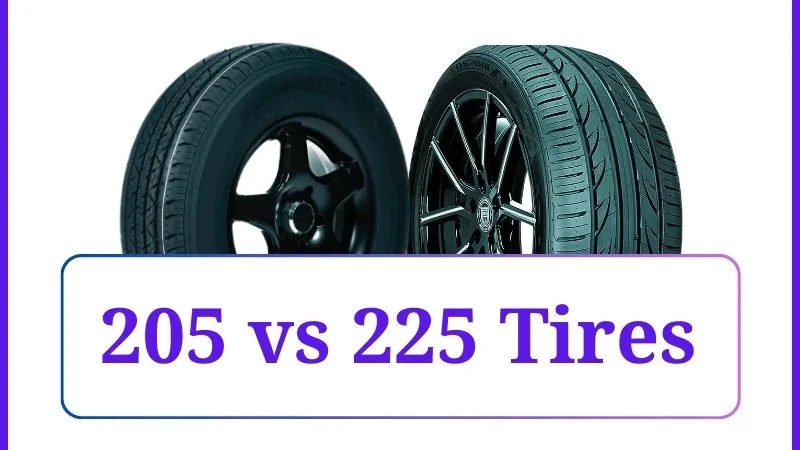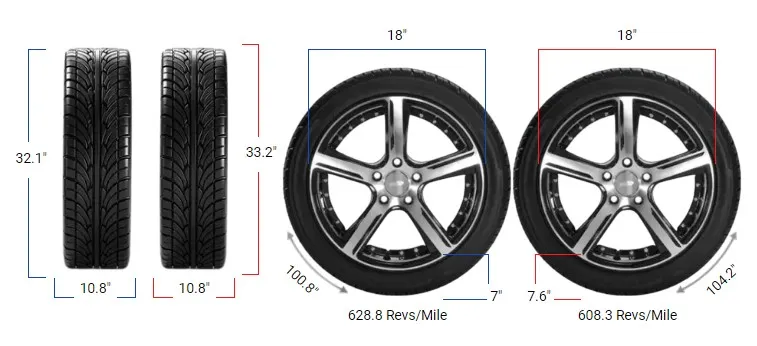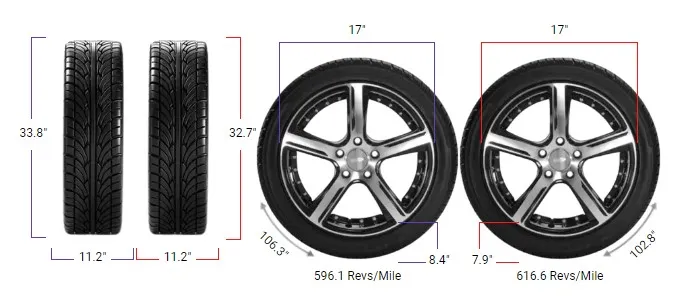205 vs 225 Tires

The primary difference between 205 and 225 tires is their width. The 2025 tires is about 20 mm wider than the 205 tires. The 205 tire measures 205 millimeters in width, while the 225 tire is 225 millimeters wide, giving the latter an additional 20 mm of width.
This difference in width can significantly influence how your vehicle handles, how it feels on the road, and how efficient it is in terms of fuel consumption.
The wider 225 tire creates a larger contact patch with the road, providing enhanced traction and stability during cornering and high-speed driving.
This makes it ideal for those who seek improved handling performance and stability. However, the increased width also means higher rolling resistance, which may slightly reduce fuel efficiency compared to the narrower 205 tire.
On the other hand, 205 tires offer a smaller contact patch, resulting in reduced rolling resistance and improved fuel efficiency, making them a suitable choice for drivers who prioritize economy and comfort.

Fitment Guide
Before deciding to switch between 205 and 225 tires, it is important to ensure that they will fit your vehicle’s rims correctly. Below is a summary of the Ideal Rim Width Range for each tire size:
- 205 tire: Compatible with rims that are 6.0 to 7.5 inches wide.
- 225 tire: Suitable for rims ranging from 6.5 to 8.0 inches wide.
The Ideal Rim Width Range must overlap for both sizes. In this case, 205 and 225 tires are compatible with rims that are 6.5 to 7.5 inches wide, making a swap possible without changing the rims.
The aspect ratio and rim diameter must remain consistent, or the overall diameter difference between the two tire sizes must be within 3% to maintain speedometer accuracy and proper vehicle handling.

On-Road Performance
The 225 tire offers improved handling and stability due to its wider contact patch. This makes it a better choice for drivers who enjoy a sporty driving experience or need more stability during high-speed driving. The increased grip is especially beneficial during cornering and in wet conditions, where stability is key to maintaining control.
On the other hand, 205 tires have a narrower profile, which can make steering feel lighter and more responsive, particularly in urban environments. The reduced rolling resistance also contributes to a more predictable and effortless driving experience, making 205 tires suitable for city driving and conditions where maneuverability is important.
Fuel Efficiency: 205 tires generally offer better fuel efficiency due to their narrower width, which reduces rolling resistance. This means the vehicle requires less energy to maintain speed, leading to improved fuel economy. For drivers who cover long distances or prioritize reducing fuel costs, 205 tires are a practical option.
In contrast, 225 tires provide enhanced traction and stability, but their increased width leads to higher rolling resistance, which can slightly reduce fuel efficiency. This trade-off is worth considering if handling and performance are more important than maximizing fuel savings.
Ride Comfort: When it comes to ride comfort, 225 tires may provide a smoother ride thanks to their wider contact patch, which helps absorb road imperfections more effectively. This can be especially advantageous on highways and rougher roads, where a wider tire can help smooth out bumps and improve overall ride quality.
However, 205 tires tend to generate less road noise at moderate speeds, contributing to a quieter cabin and a more peaceful driving experience. The firmer ride can also make 205 tires feel more responsive, which some drivers may prefer for everyday driving.

Off-Road Performance
Traction on Loose Surfaces: For light off-road use, 225 tires provide better traction on loose surfaces such as gravel, sand, or mud.
The wider contact area helps distribute the vehicle’s weight, reducing the likelihood of getting stuck and enhancing overall stability on challenging terrain. In contrast, 205 tires may offer better maneuverability in off-road situations where precise control is needed.
The narrower profile allows the tire to dig into loose surfaces more effectively, making it a better choice for navigating rocky trails or tight paths. Depending on your off-road needs, either tire could provide advantages based on the specific type of terrain.
Speedometer Impact
Switching from 205 to 225 tires can also impact the accuracy of your vehicle’s speedometer and odometer. If the overall diameter of the tire changes significantly, it may cause the speedometer to display an incorrect speed.
For example, if the 225 tire has a larger overall diameter than the 205 tire, the speedometer may indicate a speed that is lower than your actual speed.
To maintain accurate speed and distance readings, it may be necessary to recalibrate the speedometer if the difference in overall diameter exceeds 3%.
This recalibration ensures reliable performance metrics and helps keep you informed of your vehicle’s actual speed and distance traveled.

Benefits of 225 Tires:
- Enhanced Traction and Stability: The wider contact patch provides better traction, especially in wet conditions and during cornering.
- Improved Ride Comfort: The larger surface area helps absorb bumps, resulting in a smoother ride on rough roads.
- Better Off-Road Capability: The wider footprint offers improved flotation on loose surfaces, making 225 tires suitable for light off-roading.
Drawbacks of 225 Tires:
- Reduced Fuel Efficiency: The increased rolling resistance of 225 tires can lead to slightly lower fuel efficiency, particularly in city driving.
- Higher Road Noise: The wider profile may contribute to more road noise at higher speeds.
Benefits of 205 Tires:
- Improved Fuel Economy: The narrower width reduces rolling resistance, which translates to better fuel efficiency, ideal for long commutes.
- Lighter Steering: The narrower profile allows for easier maneuverability, especially in urban environments.
- Quieter Ride: The reduced contact patch helps minimize road noise, providing a quieter driving experience.
Drawbacks of 205 Tires:
- Reduced Traction: Compared to 225 tires, 205 tires have a smaller contact area, which may reduce traction in wet or high-speed conditions.
- Firmer Ride: The narrower profile may not absorb road imperfections as effectively, leading to a slightly firmer ride.

Difference Between 205 and 225 Tires
The main difference between 205 and 225 tires is the width. 225 tires are 20mm wider than 205 tires, impacting handling, stability, and overall vehicle performance.
Can I Use 205 Tires Instead of 225?
Yes, it is possible to use 205 tires instead of 225 tires, as the ideal rim width range for 205 tires (6.0-7.5 inches) overlaps with that of 225 tires at 6.5, 7.0, and 7.5 inches. However, the narrower tires may not provide optimal performance.
It’s vital to weigh certain aspects carefully too. Specifically, ensure new tires have the same aspect ratio and rim diameter as your current set. Any difference in overall diameter should not exceed 3% to avoid affecting speedometer readings and vehicle dynamics.
Can I Use 225 Tires Instead of 205?
Yes, you can use 225 tires instead of 205 tires. The ideal rim width range for 225 tires (6.5-8.0 inches) overlaps with that of 205 tires at 6.5, 7.0, and 7.5 inches, ensuring compatibility. Also, bear in mind these crucial considerations.
Replacement tires need to match your current aspect ratio and rim diameter. Any variation in overall diameter should stay within 3% to avoid compromising speedometer accuracy and vehicle handling.
Can You Put 205 Tires on 225 Rims?
Yes, you can put 205 tires on rims designed for 225 tires. The overlapping ideal rim widths at 6.5, 7.0, and 7.5 inches ensure proper fitment.
Can You Put 225 Tires on 205 Rims?
Yes, it is possible to put 225 tires on rims designed for 205 tires, as they share ideal rim widths at 6.5, 7.0, and 7.5 inches. However, using wider tires on narrower rims may affect handling and tire wear.
Our Observation
Deciding between 205 and 225 tires involves weighing the benefits of traction, handling, comfort, and fuel efficiency.
205 tires are an excellent choice for those who prioritize fuel economy and easy maneuverability, while 225 tires are ideal for drivers seeking enhanced stability, traction, and off-road performance.
It is always advisable to consult with a tire professional before making any changes to ensure the tire size is suitable for your vehicle and driving requirements.



